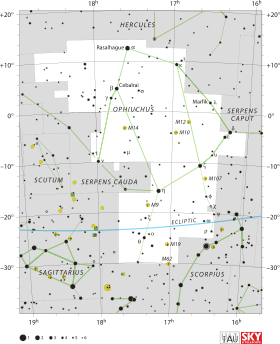Theta Ophiuchi

| |
| Observation data Epoch J2000 Equinox J2000 | |
|---|---|
| Constellation | Ophiuchus |
| Right ascension | 17h 22m 00.57935s[1] |
| Declination | –24° 59′ 58.3670″[1] |
| Apparent magnitude (V) | +3.26[2] |
| Characteristics | |
| Spectral type | B2 IV[3] |
| U−B color index | –0.86[4] |
| B−V color index | –0.23[4] |
| Variable type | β Cep |
| Astrometry | |
| Radial velocity (Rv) | –2[5] km/s |
| Proper motion (μ) | RA: –7.37[1] mas/yr Dec.: –23.94[1] mas/yr |
| Parallax (π) | 7.48 ± 0.17[1] mas |
| Distance | 436 ± 10 ly (134 ± 3 pc) |
| Absolute magnitude (MV) | –2.4[2] |
| Details | |
| Mass | 8.8 ± 0.2[3] M☉ |
| Radius | 6.3[6] R☉ |
| Luminosity | 5,000[2] L☉ |
| Surface gravity (log g) | 3.950 ± 0.006[7] cgs |
| Temperature | 22,260 ± 280[7] K |
| Metallicity [Fe/H] | –0.15 ± 0.12[8] dex |
| Rotational velocity (v sin i) | 30[9] km/s |
| Age | 21.3 ± 5.8[3] Myr |
| Other designations | |
Theta Ophiuchi (θ Oph, θ Ophiuchi) is a multiple star system in the equatorial constellation of Ophiuchus. It lies on the "right foot" of the serpent-bearer, and is only a little to the southwest of the Kepler's Star, the nova of 1604. According to Richard H. Allen's, Star Names: Their Lore and Meaning (1899), θ Oph together with ξ Oph formed the Sogdian Wajrik "the Magician", the Khorasmian Markhashik "the Serpent-bitten" and with η Oph the Coptic Tshiō, "the Snake", and Aggia, "the Magician".[11] This star has an apparent visual magnitude of +3.26,[2] making it readily visible to the naked eye. Based upon parallax measurements from the Hipparcos mission, it is located at a distance of roughly 436 light-years (134 parsecs) from Earth.[1]
Theta Ophiuchi appears to be a triple star system. The brightest component is a spectroscopic binary with an orbital period of 56.71 days and an eccentricity of 0.17. The tertiary component is 5.5 magnitude star with a stellar classification of B5. It is located at an angular separation of 0.15 arcseconds from the binary pair.[12] This system is a proper motion member of the Upper Scorpius sub-group in the Scorpius-Centaurus OB association, the nearest such co-moving association of massive stars to the Sun.[2]
The primary component of this system is a variable star of the Beta Cephei type with a short period of just 3h 22m.[13] It has nearly nine[3] times the mass of the Sun and more than six[6] times the Sun's radius. Although only 21 million years old,[3] it has begun to evolve away from the main sequence and has become a subgiant star with a stellar classification of B2 IV.[3] This massive star is radiating around 5,000 times the luminosity of the Sun from its outer atmosphere at an effective temperature of about 22,260 K,[7] giving it the blue-white hue of a B-type star.[14]
References
- 1 2 3 4 5 6 van Leeuwen, Floor (November 2007), "Validation of the new Hipparcos reduction", Astronomy and Astrophysics, 474 (2): 653–664, arXiv:0708.1752v1
 , Bibcode:2007A&A...474..653V, doi:10.1051/0004-6361:20078357 Note: see VizieR catalogue I/311.
, Bibcode:2007A&A...474..653V, doi:10.1051/0004-6361:20078357 Note: see VizieR catalogue I/311. - 1 2 3 4 5 de Geus, E. J.; de Zeeuw, P. T.; Lub, J. (June 1989), "Physical parameters of stars in the Scorpio-Centaurus OB association", Astronomy and Astrophysics, 216 (1-2): 44–61, Bibcode:1989A&A...216...44D
- 1 2 3 4 5 6 Tetzlaff, N.; Neuhäuser, R.; Hohle, M. M. (January 2011), "A catalogue of young runaway Hipparcos stars within 3 kpc from the Sun", Monthly Notices of the Royal Astronomical Society, 410 (1): 190–200, arXiv:1007.4883
 , Bibcode:2011MNRAS.410..190T, doi:10.1111/j.1365-2966.2010.17434.x
, Bibcode:2011MNRAS.410..190T, doi:10.1111/j.1365-2966.2010.17434.x - 1 2 Johnson, H. L.; et al. (1966). "UBVRIJKL photometry of the bright stars". Communications of the Lunar and Planetary Laboratory. 4 (99). Bibcode:1966CoLPL...4...99J.
- ↑ Evans, D. S. (June 20–24, 1966), Batten, Alan Henry; Heard, John Frederick, eds., The Revision of the General Catalogue of Radial Velocities, University of Toronto: International Astronomical Union, Bibcode:1967IAUS...30...57E
- 1 2 Underhill, A. B.; et al. (November 1979), "Effective temperatures, angular diameters, distances and linear radii for 160 O and B stars", Monthly Notices of the Royal Astronomical Society, 189: 601–605, Bibcode:1979MNRAS.189..601U, doi:10.1093/mnras/189.3.601
- 1 2 3 Briquet, M.; Morel, T.; Thoul, A.; Scuflaire, R.; Miglio, A.; Montalbán, J.; Dupret, M.-A.; Aerts, C. (November 2007), "An asteroseismic study of the β Cephei star θ Ophiuchi: constraints on global stellar parameters and core overshooting", Monthly Notices of the Royal Astronomical Society, 381 (4): 1482–1488, arXiv:0706.3274
 , Bibcode:2007MNRAS.381.1482B, doi:10.1111/j.1365-2966.2007.12142.x
, Bibcode:2007MNRAS.381.1482B, doi:10.1111/j.1365-2966.2007.12142.x - ↑ Daszyńska-Daszkiewicz, J.; Niemczura, E. (April 2005), "Metallicity of mono- and multiperiodic β Cephei stars", Astronomy and Astrophysics, 433 (3): 1031–1035, arXiv:astro-ph/0410442
 , Bibcode:2005A&A...433.1031D, doi:10.1051/0004-6361:20040397
, Bibcode:2005A&A...433.1031D, doi:10.1051/0004-6361:20040397 - ↑ Abt, Helmut A.; Levato, Hugo; Grosso, Monica (July 2002), "Rotational Velocities of B Stars", The Astrophysical Journal, 573 (1): 359–365, Bibcode:2002ApJ...573..359A, doi:10.1086/340590
- ↑ "HD 157056 -- Variable Star", SIMBAD Astronomical Database, retrieved 2007-01-21
- ↑ Allen, R.H. (1899), Star Names: Their Lore and Meaning, p. 297
- ↑ Eggleton, P. P.; Tokovinin, A. A. (September 2008). "A catalogue of multiplicity among bright stellar systems". Monthly Notices of the Royal Astronomical Society. 389 (2): 869–879. arXiv:0806.2878
 . Bibcode:2008MNRAS.389..869E. doi:10.1111/j.1365-2966.2008.13596.x.
. Bibcode:2008MNRAS.389..869E. doi:10.1111/j.1365-2966.2008.13596.x. - ↑ Burnham, Robert (1978), Burnham's celestial handbook: an observer's guide to the universe beyond the solar system, 3, Courier Dover Publications, p. 1372, ISBN 978-0-486-23673-5
- ↑ "The Colour of Stars", Australia Telescope, Outreach and Education, Commonwealth Scientific and Industrial Research Organisation, December 21, 2004, retrieved 2012-01-16